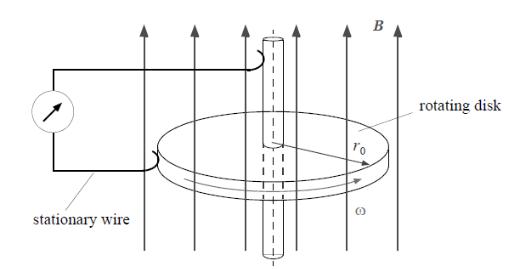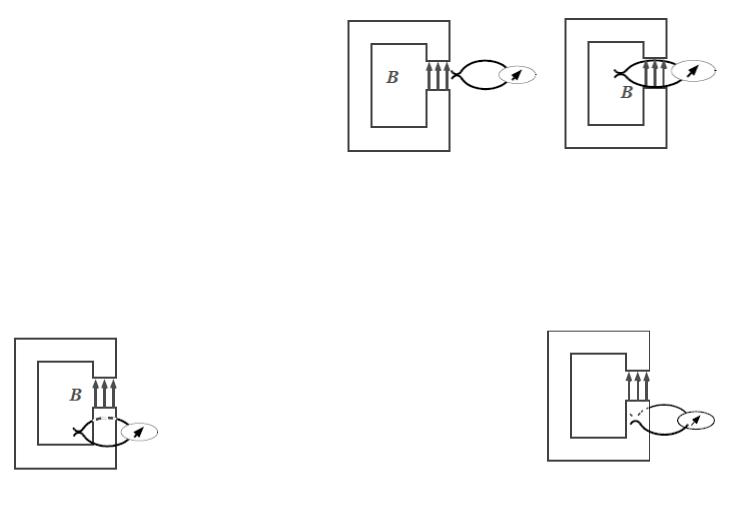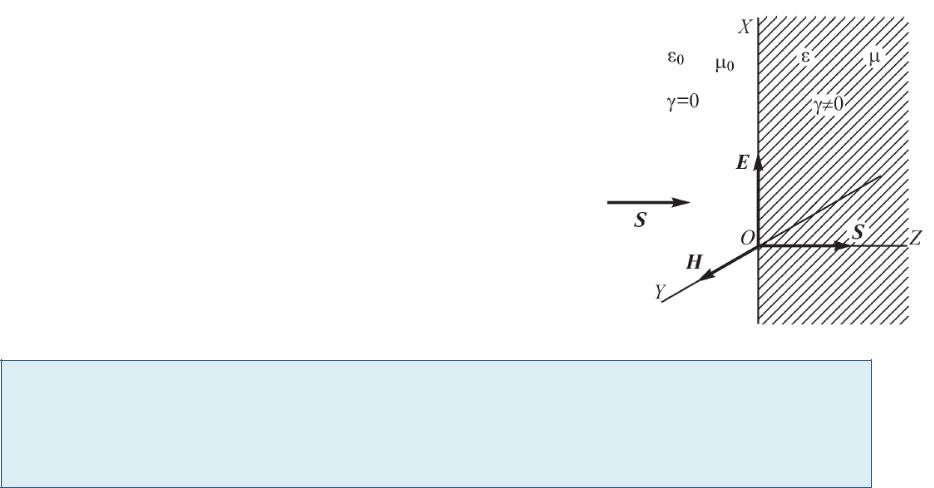
- •Advanced chapters of theoretical electroengineering.
- •Lecture 6
- •Faraday’s Law
- •Induction by a temporal change of B
- •Induction through the motion of the conductor.
- •Induction through the motion of the conductor.
- •Induction through the motion of the conductor.
- •Induction through the motion of the conductor.
- •Induction by simultaneous temporal change of B and motion of the conductor.
- •Induction by simultaneous temporal change of B and motion of the conductor.
- •Unipolar generator.
- •Unipolar generator.
- •Unipolar generator.
- •Hering’s paradox. (Парадокс Геринга)
- •Hering’s paradox.
- •Diffusion of electromagnetic fields.
- •Diffusion of electromagnetic fields.
- •Periodic electromagnetic field in the conductors.
- •Periodic electromagnetic field in the conductors.
- •Penetration of the electromagnetic field into a conductor
- •The skin effect.

Unipolar generator.
(Униполярный генератор)
Consider the wheel made of conductive material rotating with a constant angular frequency ω in a uniform magnetic field.
Two brushes provide connectivity between the stationary outside part of the circuit that includes a voltmeter and the rotating part inside.
The result of this closed circuit is an induced EMF
11

Unipolar generator.
Velocity is a function of the |
v r |
|
||
distance to the center. |
|
|
||
Electric field intensity: |
E B r |
|
||
|
|
0 |
Br02 |
|
|
|
|
2 |
|
U E dr |
Er dr |
|
|
|
|
|
r0 |
|
|
The flux passing through the contour is constant! |
0 |
|||
12

Unipolar generator.
Another consideration may take place.
The circuit shown here is also a possibility.
The magnetic flux in this case is:
|
|
r2 |
B |
r2 t |
B |
|
|
|
|
|
|
0 |
0 |
|
|
|
|
||
|
|
|
|
|
|
|
|||
|
2 |
2 |
|
|
|
2 |
|
||
The induced EMF is: |
|
U |
d |
|
|
r |
B |
||
|
dt |
|
0 |
||||||
|
|
2 |
|
||||||
However, this explanation is not very persuasive.
What is always true: |
|
B |
Using the flux in this certain |
E v |
situation makes no sense. |
||
|
|
|
13

Hering’s paradox. (Парадокс Геринга)
Consider a magnet without leakage. It has an air gap that is penetrated by a magnetic field.
Outside the magnet, there is a conducting loop with elastic contacts that ensure a closed circuit at all times. The circuit also includes a voltmeter
Movement of the coil causes a voltage impulse |
Udt |
|
The loop is |
Finally, the loop is |
further moved to |
pulled from the |
a new position |
magnet to the outside |
14

Hering’s paradox.
0 |
0 |
The spring contacts open, but stay in contact with the magnet, so the circuit is still closed at all times
Experiment demonstrated – there is no induced EMF.
This may appear like a paradox which represents a contradiction to Faraday’s Law. Essential is, however, that the flux change is not related to the motion of the conductor.
|
Inside the magnet: field exists but there is no movement |
E v B |
Outside the magnet: conductor moves, but there is no field. |
15
Diffusion of electromagnetic fields.
Consider electromagnetic field in conductor.
The displacement currents are neglected. No free charges.
|
B |
divB 0 |
B H |
|
curlE |
||||
Basic equations: |
t |
divJ 0 |
J E |
|
curlH J |
E |
|||
divE 0 |
|
|||
|
|
|
Differential equations for the electric field intensity:
|
|
|
|
|
|
|
|
|
|
|
E |
B |
|
H |
J |
E |
|||||
t |
|
t |
t |
t |
||||||
|
|
|
|
|
|
|
||||
Mathematical |
|
|
|
|
|
|
2 |
|
2 |
E |
transformation: |
|
|
E E E |
|||||||
|
|
|
|
|
|
|
|
|
|
|
16
Diffusion of electromagnetic fields.
Diffusion equations for the electromagnetic field characteristics:
2 |
E |
2 |
|
J |
2 |
B |
2 |
H |
2 |
|
A |
E |
t |
J |
|
t |
B |
t |
H |
t |
|
A |
t |
Such equations (applied to scalar variables) describe processes of the particle diffusion, thermal processes.
One-dimensional equations: (here we assume that only x- component of the E and y- component of H exist)
2 E |
x |
E |
x |
||||
z2 |
t |
||||||
|
|
|
|
||||
2 H y |
|
|
H y |
|
|
||
z2 |
|
t |
|
||||
|
|
|
|||||
17

Periodic electromagnetic field in the conductors.
Quasi-stationary approach:
Ex Em sin( t E ); H y Hm sin( t H )
Applying the complex method:
|
j E |
; |
|
j H |
|
Em Eme |
Hm Hme |
||||
|
|
Differential equations in complex form:
2 |
|
|
d |
2 |
|
|
|
|
|
|
|
|
E |
m |
|
|
|
||||
d Hm |
|
|
|
|
|
|
|
dHm |
||
|
|
|
|
|
|
|
||||
|
|
|
|
|
|
|
j E |
|
|
|
dz2 |
j Hm |
dz |
2 |
|
m |
Em |
dz |
|||
|
|
|
|
|
|
|||||
18

Periodic electromagnetic field in the conductors.
|
|
d |
2 |
|
|
|
|
|
|
|
|
|
|
|
|
|
|
|
|
|
|
|
|
|
|
|
|
Equation: |
|
Hm |
|
|
|
|
|
|
|
0 |
|
|
|
|
|
|
|
|
|
|
|
|
|||||
|
|
dz2 |
|
j Hm |
|
|
|
|
|
|
|
|
|
|
|
|
|
||||||||||
|
|
|
|
|
|
|
|
|
|
|
|
|
|
|
|
|
|
|
|
|
|
|
|
|
|
|
|
Solution for the complex field intensity: |
|
|
|
|
|
|
|
|
|
|
|
|
|||||||||||||||
|
|
|
|
|
z |
|
|
|
|
|
z |
|
|
|
|
|
z |
|
|
|
|
|
|
||||
|
Hm A1e |
|
|
|
A2e |
|
|
|
or |
|
|
|
|
|
|
|
|
|
|||||||||
|
|
|
|
|
|
|
Hm A1e |
|
|
|
|
|
|
|
|||||||||||||
|
|
|
|
|
|
|
|
|
|
|
|
|
|
|
|
|
|
|
|
|
|
|
|
|
|
|
|
|
|
|
|
|
|
|
|
|
|
|
|
|
|
|
|
|
|
|
|
|
|
|
|||||
Parameter α: |
|
|
|
|
|
|
|
|
e j |
2 e j 4 |
|
1 j |
|
|
|
||||||||||||
|
|
|
|
|
j |
|
|
|
|
||||||||||||||||||
|
|
|
|
|
|
|
|
|
|
|
|
|
|
|
|
|
|
|
|
|
|
|
2 |
|
|
|
|
|
|
|
|
|
|
|
|
|
|
|
|
|
|
|
|
|
|
|
|
|
|
|
|
||||
Using designation: |
|
|
|
|
k |
|
|
|
|
|
|
|
kz |
e |
jkz |
||||||||||||
|
|
|
|
2 |
|
|
|
|
|
|
|
Hm Hm0e |
|
|
|
||||||||||||
|
|
|
|
|
|
|
|
|
|
|
|
|
|
|
|
|
|
|
|
|
|
|
|
|
|||
|
|
|
|
|
|
|
|
|
|
|
|
|
|
|
|
|
|
|
|
|
|
|
|
|
|
|
|
Solution for the field intensity: |
H Hm0e kz sin( t H0 |
kz) |
19

Penetration of the electromagnetic field into a conductor
1 |
|
|
2 |
|
- the penetration length |
|
|
||||||
k |
|
|
|
|
Amplitude of the electromagnetic wave dumps according to exponential dependence:
H Hm0e kz sin( t H0 kz 4 )
20
